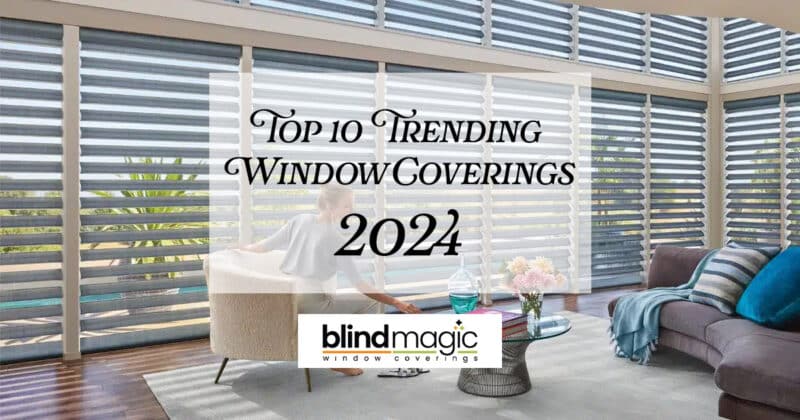When the temperature outside is different from the temperature inside, heat travels in and out of the rooms through windows. Heat flow through windows can be especially dramatic in the winter when the temperature difference between the inside and outside may be greater than 21 degrees. When we add insulating window coverings, we reduce this flow of heat. We’re going to use a little bit of science to take a look at three types of heat flow, conduction, convection, and radiation, and explore how each of them can be controlled through window coverings.
Conduction
When warm air comes in contact with a cold pane of glass the glass molecules on that surface are excited by the heat and begin to move more rapidly. These rapidly moving molecules interact with slower-moving molecules transferring some of their heat. This is called conduction here you can see that the heat from the warm air is quickly transferred through the glass to the outside of the pane. Glass is a good conductor of heat so much that more heat is lost through the windows than through the walls. With high-quality insulating shades lowered over the windows, the air pockets in the shades act as insulation to reduce contact between the cold windows and the warm air. This slows the transfer of heat through the windows and increases the energy efficiency of heating the room.
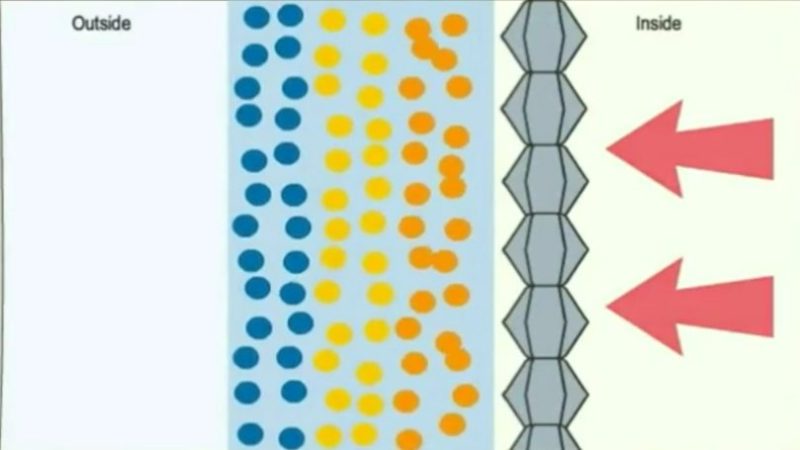
Convection
Cooled air is denser than warm air so it tends to sink towards the floor. This causes the warm air in the room to rise and float on top of the cooler air which is where chilly drafts that hit your legs come from. When this warmer air touches the cold windowpane it cools and sinks. This process, convection, creates air currents to constantly move warmer air against the cooler glass. Even with airtight windows, a room can seem drafty because of these airflows. By covering windows you are reducing the amount of warm air that comes in contact with the cold window panes. Since there is less cool air sinking, this reduces the air currents making the room feel less drafty. Reducing the air currents also means that less heat is moved towards and transferred through the windows.
All of this means that covering the windows makes the room feel more comfortable AND saves energy!

Radiant Heat Loss
If you’re in a warm room on a cold winter day and a nearby window is uncovered, you will lose heat on the side of your body facing the window and feel uncomfortable. By lowering the insulated shade that is warmer than the cold windowpane so it emits more radiant heat making people in the room feel warmer and more comfortable.
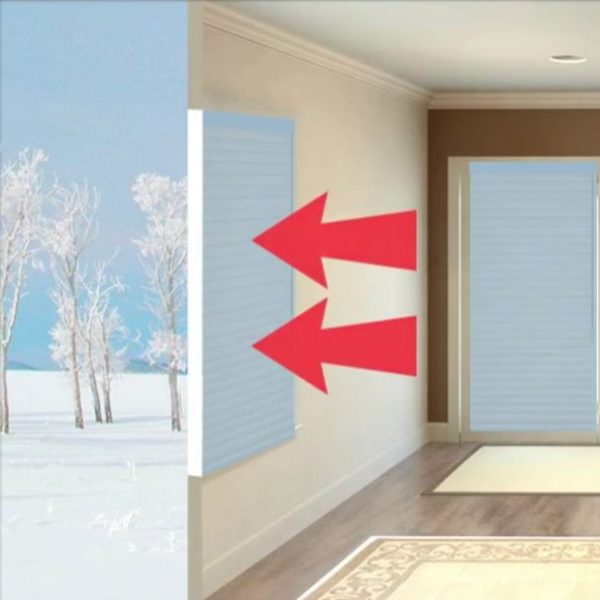
In general, we want to reduce Solar Heat in summer and allow more in winter. Solar Heat is the solar energy that enters the home and becomes heat once it gets inside. An interesting aspect of Solar Heat gain is that it is a one-way street. The relatively short wavelengths of the solar spectrum pass through the standard glass fairly easily. But when they strike objects and become heat, that heat becomes long-wavelength infrared, those long wavelengths cannot pass back through the glass and instead bounce throughout the room heating it.
When we apply window coverings to a room to reduce the solar heat gain, the solar waves are still hitting the window, but they no longer enter the room.
Solar energy does not hit windows at the same angle in summer and winter. In winter when the sun is low in the sky. Solar energy can pour into Windows and help heat the house. But in summer with the sun higher in the sky, less area of the windows are exposed to the sun. In addition, the angle of the sun is so great that much of the solar energy is reflected. South-facing windows are tailor-made for energy efficiency, allowing significantly greater solar heat gain in the winter than in summer.
The problem in the summer is east and west windows. Solar energy pours through them six or seven hours a day. Skylights can also be challenging for heat gain in the summer. This is why it’s so important to have control of solar heat provided by window coverings in winter. Shades that are normally lower to control heat loss can be raised to allow solar heat gain whenever the sun hits the glass directly.
In the summer shades can be lowered to reduce the heat gain when the sun is directly hitting those windows and raised for light at other times. You can use energy efficiency timetables as a tool to help effectively control solar heat. The timetables provide guidelines on the hours that you should open and close your shades each month for maximum energy efficiency.
These timetables are guidelines only. Local climate and weather conditions play a large role in when you should open and close your shades to best control solar heat. In addition to the timetables themselves, automation can help you operate your window coverings for maximum energy efficiency. With platinum technology systems including the power rise, power, glide, and power tilt. There are several cost-effective automation options.
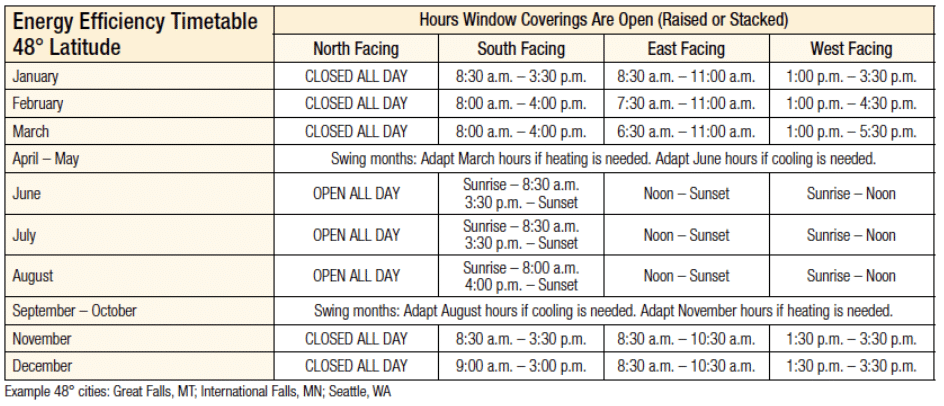
Daylighting is the use of natural light to illuminate home interiors. The beneficial effect of window coverings can be seen very clearly in these before and after pictures. In the image on the left, the light is harsh and glaring near the windows. The unseen back of the room would seem very dark in contrast to the image on the right. Silhouette Window Shadings have diffused and dispersed the light throughout the room making it a much more comfortable space for the occupants of the room. Silhouette Nantucket shadings are absolutely the best Hunter Douglas products for daylighting. They soften and diffuse the light and the veins can be angled to direct light up toward the ceiling and deeper into the room.
Improved Daylighting allows us to reduce our use of electric lights during the day, making this another way window coverings can contribute to a reduction in energy consumption.
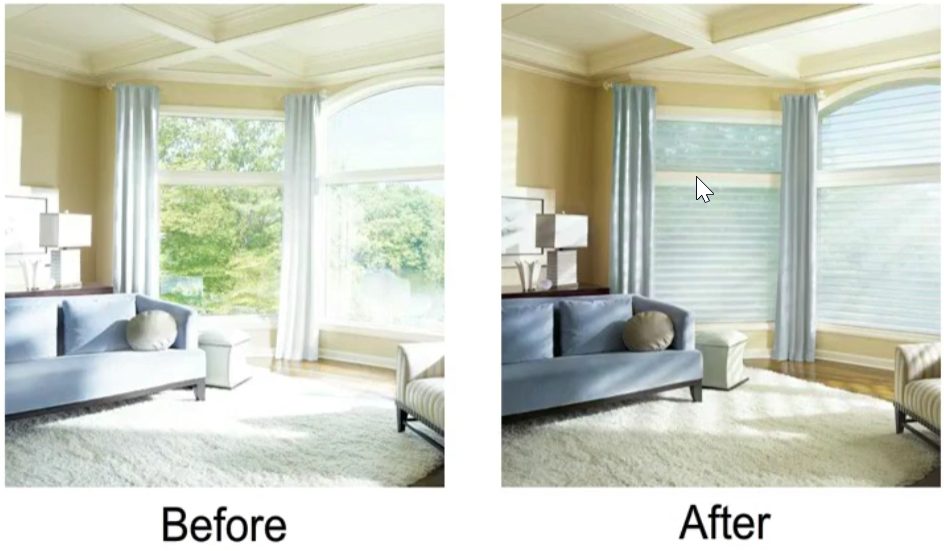
This is a question we’ve been asked more than once, so we decided to write a whole blog post about it. Click the button below to view the selections.



